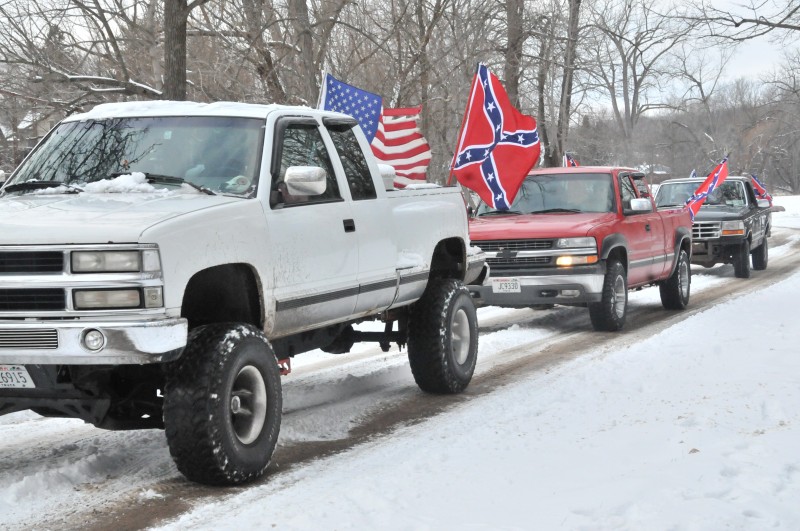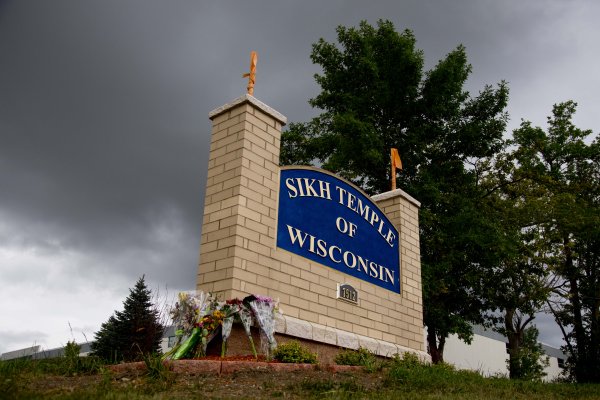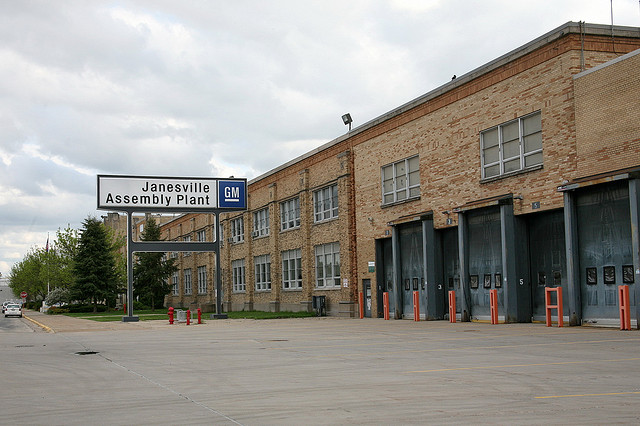I remember the first time I saw a Confederate flag in Wisconsin.
It was my sophomore year at the University of Wisconsin-Madison, and I was driving with my friend Kevin to go see The Roots in Milwaukee. Complaining how we needed to drive an hour and a half just to see a decent hip-hop show, Kevin told me to speed it up. I moved into the fast lane, casually glancing at the truck ahead of us — and there it was. Blazing brightly at us from the bumper of an old Chevy pickup truck, there shined the Confederacy’s version of red, white, and blue.
I couldn’t believe it. I’d seen the Confederate flag before — growing up in DC, I played soccer in Virginia and saw the occasional diagonally-crossed banner on cars along the aptly-named Robert E. Lee Highway. As repulsive as they were, those Virginia flag-wavers could at least pretend to hide behind Southern pride as inspiration.
But this dude driving his pickup truck up here in Wisconsin, what pride was he claiming? Proud to be south of Canada?
A black guy and a Jew, Kevin and I weren’t going to honk and ask for clarification. Both of us already knew the answer. That flag meant – as it always means – white pride. The deadliest pride of them all.
A White Suicide Bomber
Two weeks ago in Oak Creek, Wis., a man named Wade Michael Page entered a Sikh temple with a semi-automatic weapon and started shooting. By the time he was done, he had killed six people, including Satwant Singh Kaleka, the temple’s founder; Prakash Singh, an assistant priest; and Suveg Singh, an 84-year-old former dairy farmer from India spending his last years in America’s own dairyland. Page shot them all down in a matter of minutes. Then, after he exacted his mistaken 9/11-revenge fantasy, Page turned the gun on himself. No one will call him a suicide bomber, but that’s less because of the choice of his weapon than the color of his skin.
Since the shooting, we have learned that Page was a white supremacist of the highest order. An Army veteran, he played guitar in neo-Nazi heavy metal bands with creative names like End Apathy and Definite Hate. He had a tattoo in memorial of 9/11. He referred to people of color as “dirt people,” and told one white coworker who was dating a Latina woman that he was a “race traitor.” Dude took his racism serious. And in a country where it’s easier to get a gun than a job, Page was able to put his hate-filled songs into practice.
The media has been right to highlight Page’s white power background, but they often take this fact to the wrong conclusions. Fox News and CNN both try to paint Page as a crazy outlier to “peaceful, mainstream America.” Meanwhile, they call the Oak Creek shooting a “tragic mistake…against the peaceful Sikh community,” as if mass murder towards Muslims, Page’s presumed target, would have been fine and dandy. Who knew that peaceful America was so picky in its application of racist violence?
Therein is the crux of the tragedy in Oak Creek: as horrific as Page’s actions were, one heavy-metal maniac is just the tip of the white supremacy iceberg. The rocky foundations of racism – from the ever-expanding War on Terror to the prison-industrial complex to the local news that criminalizes black and brown people every night at 6pm – float along unexamined below the surface, ready to sink this titanic ship we call America. Â
And right there in the heart of it all, lies my beloved, schizophrenic college homeland: good old Wisconsin.
The Geography of Hate
Wisconsin has a long progressive history, from the days of Governor Robert “Fighting Bob” LaFollette to last year’s labor uprising at the state Capitol, but it also has a strong element of far-right conservatism and racial animosity. In recent years, that element has been growing, especially in the suburbs outside Milwaukee. One of those suburbs is Oak Creek.
An industrial town just south of Milwaukee, Oak Creek is 90% white. Recently beating out Detroit as the most segregated city in America, Milwaukee is racially divided both within the city (the black North Side, the Latino South Side, and white folks on the east) and between the city and its suburbs. Fueled by a mix of hyper-individualism and racist fears of the city, affluent suburbs like Waukesha and Brookfield have become fertile ground for national right-wing politicians.
Wisconsin Gov. Scott Walker is best known for sparking last year’s labor rebellion with his vicious anti-union legislation. Before his statewide damage, though, he made his mark in the Milwaukee suburbs as County Executive by vilifying and then denying benefits to welfare recipients (read: black people) in the city. Meanwhile, the local Congressman, Rep. James Sensenbrenner, in 2006 sponsored the most draconian anti-immigrant bill in decades, inciting a massive immigrant rights movement but also laying the groundwork for the current crackdown and racial profiling in Arizona. Small-town Wisconsin comes up big when it comes to pushing the Far Right forward.
From the local Fox News outlet to the Republican Party headquarters (is there a difference?), the winning combination in the Milwaukee suburbs is simple and effective: bash early, bash often. Find that all-too-easy “Other” (be they black, immigrant, Muslim, or just plain poor) and make them out to be the threat to all things right (meaning white) in the world. Applaud when Ann Coulter says Muslims shouldn’t be allowed on airplanes but should instead “take a camel.” Laugh when Rush Limbaugh comes to town and says “the NAACP should have riot rehearsal.” And then ask for a campaign donation.Â
This culture of demonization indeed leads to higher ratings — and higher gun violence. Two months before the Oak Creek tragedy, Darius Simmons, a 13-year-old black boy was shot dead in Milwaukee by his 75-year-old white neighbor, John Henry Spooner, after falsely being accused of breaking into Spooner’s home. In May, another white man in Milwaukee killed unarmed 20-year-old Bo Morrison in a case eerily similar to Trayvon Martin. Meanwhile, outside of Wisconsin, the NYPD spies on Muslims far beyond New York, and President Obama bombs (or threatens to bomb) every country from Libya to Pakistan. All this high-level fear mongering was bound to trickle down somehow.Â
In March, a U.S. soldier in Afghanistan killed 16 innocent civilians, sparking fierce Afghani protests. The Pentagon, of course, publicly disowned the soldier, saying he “acted alone.” The media is now saying the same thing about Wade Michael Page, himself an Army veteran. But we never stop to ask: is the problem the individual, or the institution? With the Oak Creek shooting, is the issue that Page “got his orders wrong” — or that he never forgot them?
Paul Ryan and The Economics of Violence
Six days after the Oak Creek massacre, Republican Presidential candidate Mitt Romney chose Rep. Paul Ryan to be his Vice Presidential nominee. Apparently, the announcement of Ryan’s selection was delayed several days because of the shooting — Â not merely because it was a national tragedy but because Ryan himself is the Congressman for southeast Wisconsin, including Oak Creek. Last week, Ryan attended the memorial service at the Sikh Temple and offered his condolences to the victims. At the same time that Ryan condemns the violence, however, our next potential Vice President practices his own brand of economic warfare.
Paul Ryan has long been a darling of the radical Right. His reactionary budget policies, now part of the Republican presidential campaign, call for the dismantling of Social Security, Medicare, food stamps, and every other major social program for poor and middle-class people. Meanwhile, he pushes (as does President Obama, by the way) free trade agreements and corporate tax giveaways that destroy the industrial workforce that was once the core of his very district. For a painful glimpse at what a Paul Ryan economy would look like, all you need to do is look at Paul Ryan’s hometown and political birthplace.
Janesville, Wis. is a small city on the Rock River, once home to the state headquarters of the KKK. Janesville is best known for its massive GM factory, which opened back in 1919 and was the region’s largest employer for four generations of local residents. After years of downgrading the facility and moving production to Mexico for cheaper labor, GM shut down the entire factory in 2008. Taking into account the ripple effect of suppliers and related services, nine thousand people suddenly lost their good-paying, union jobs. 9,000 jobs! In a city of 65,000 people, that’s not chump change.
Meanwhile, over in Oak Creek, the corporate deindustrialization that began in the 1970s has been making its final body counts: Delphi (closed 2007, 200 jobs lost); Viasystems (2008; 250 jobs) CSM Bakery (2011; 100 jobs); and the carnage continues. This is economic warfare, with the Rust Belt as battleground and working people as casualties.
Shuttered factories, foreclosed homes, decimated communities — these issues actually hit communities of color the hardest. But in recent years, white, working-class towns like Oak Creek have increasingly felt their fair share of pain. And when all these jobless or marginally employed white workers (white men, in particular) look for a place to direct that pain, they do so in one of two directions. Some vent their anger at GM or Wells Fargo or Bain Capital. But many others, following the example set by right-wing media, religious, and political leaders, vent their anger at the ever-present, easily vilified “Other,” those with brown skin and names they can’t pronounce.
I want to be clear — while Republicans have been terrible for Wisconsin, the Democrats have been little better, and sometimes worse. Both NAFTA and welfare reform, neoliberal policies that led directly to industrial job loss and deeper poverty in the inner city, were pushed by Bill Clinton. Fast-forward to today, Obama talks an even better game than Slick Willie but continues the same corporate economic policies. Amidst multiple wars abroad and increasing xenophobia at home, the bipartisan decimation of the southeast Wisconsin economy created a climate of resentment that made the Sikh Temple shooting predictable, if not inevitable. Â
All violence – be it economic, psychological, or physical – provokes more violence. The question for us now is how to break that cycle. How, through our individual actions and collective institutions, do we provoke peace?
Bhangra, Healing, and Justice
When I heard about the Oak Creek shooting, my first thought was: Oh my God. My second was: I hope Harpreet is okay.
Back in my University of Wisconsin days, I knew Harpreet Singh. Everyone knew Harpreet Singh. With a big beard and a bigger smile, Harpreet was one of those students on campus who was always inviting you to something. A concert. A rally. And, most importantly for Harpreet, a bhangra show.
Bhangra, the high-energy style of music and dance that combines Punjabi folk, with hip-hop, house, and reggae, has exploded in the U.S. and Europe in recent years. At the time, though, I had never heard of it. Then I went to the show.
There was Harpreet and the dozen members of the UW Bhangra Association, wearing beautiful, brightly colored outfits and dancing to the pulsing beat with the joy and ecstasy I’d only seen from Puerto Rican b-boys in the height of a Brooklyn battle. Here in the heart of white Wisconsin, at a university caught between the Western canon and its tepid  multiculturalism — here was another immigrant community, boldly navigating the place between assertion and assimilation. And they were doing it with dignity, flair, and an undeniable current of love.
That sense of love was shattered, but not broken, by the Sikh Temple shooting. Like most of Wisconsin’s Sikh community, Harpreet is from Milwaukee and a member of the nearby temple in Oak Creek. When I found out about the shooting, I went to his Facebook page and saw that he okay. Harpreet lives in Massachusetts now, but he was still close to the people in Oak Creek who lost their lives. So Harpreet did what he always does — he started taking action to help his community back in Milwaukee and calling for solidarity and action from the wider American public.Â
Solidarity and action: that is what we need. After all the vigils, the pleas and the prayers, we need action. We need to support Sikh (and Arab, and Muslim, and all) community organizations in the struggle for justice, civil liberties, and religious tolerance. And we need to start fighting the culture of hate, the economic violence, that create the conditions for homegrown terrorism to erupt.
What would a real War on Terror look like? Let’s start with full employment at living wages, integrated and affordable housing, and high-quality education for all. Shutting down prisons instead of factories, building high-speed railroads instead of border walls, and ending the wars in Afghanistan and Pakistan.
Or maybe we start with this: a bhangra show. Yes, I can see it now…a tour of free bhangra shows in every state across America. Accompanied, of course, by workshops and town halls on the history, culture, and challenges of Sikh Americans, people of color, and all struggling Americans.
In the wake of Oak Creek, let’s stop pointing fingers and guns. Instead, let us heal together. Let us organize for justice. And, through it all, let us dance.






